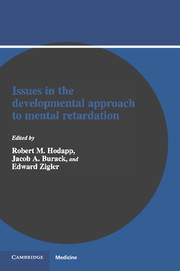Book contents
- Frontmatter
- Contents
- Preface
- Contributors
- Part 1 Developmental theory
- 1 The developmental perspective in the field of mental retardation
- 2 Differentiating mental retardation: The two-group approach and beyond
- 3 One road or many? Issues in the similar-sequence hypothesis
- 4 The similar-structure hypothesis and differential rate of development in mental retardation
- 5 Neo-environmental perspectives on developmental theory
- 6 The role of motivational factors in the functioning of mentally retarded individuals
- Part 2 Applying developmental theory to different types of retarded individuals
- Author index
- Subject index
3 - One road or many? Issues in the similar-sequence hypothesis
from Part 1 - Developmental theory
Published online by Cambridge University Press: 07 September 2010
- Frontmatter
- Contents
- Preface
- Contributors
- Part 1 Developmental theory
- 1 The developmental perspective in the field of mental retardation
- 2 Differentiating mental retardation: The two-group approach and beyond
- 3 One road or many? Issues in the similar-sequence hypothesis
- 4 The similar-structure hypothesis and differential rate of development in mental retardation
- 5 Neo-environmental perspectives on developmental theory
- 6 The role of motivational factors in the functioning of mentally retarded individuals
- Part 2 Applying developmental theory to different types of retarded individuals
- Author index
- Subject index
Summary
Workers interested in children's behavior have long disagreed about the idea that there is one, fixed, and invariant sequence of development in any particular domain. On the one hand, workers such as Piaget (1954), Kohlberg (1969), and Slobin (1970) and Lenneberg (1967) have argued that there are invariant sequences in cognition, morality, and language, respectively. From observations of children from one culture or a small set of cultures, these workers have asserted that their particular sequences of development constitute the single orderings of achievements that lead to more adaptive and higher-level functioning. Some have even argued that the search for so-called universals in development is the true mission of the developmental psychologist.
On the other hand, the quest for universals has been derided as simplistic by certain workers interested in cross-cultural (Shweder, 1984) and atypical (Switzsky, Rotatori, Miller, & Freagon, 1979) development. These workers have asserted that there are many roads to the same end point, that development is variable and individualized across children. For example, behaviorists argue that environmental conditions should be able to guide change in a number of directions – that is, in the appropriate rearing environment, any particular child could be made into “a doctor, lawyer, artist, merchant-chief and yes, even into a beggar-man and thief” (Watson, 1926, p. 10). Other workers have emphasized that the speed of development is strongly influenced by the environment (Hunt, 1980), and even that developmental sequences and end points differ from one culture to another (Miller, 1986).
- Type
- Chapter
- Information
- Publisher: Cambridge University PressPrint publication year: 1990
- 9
- Cited by



